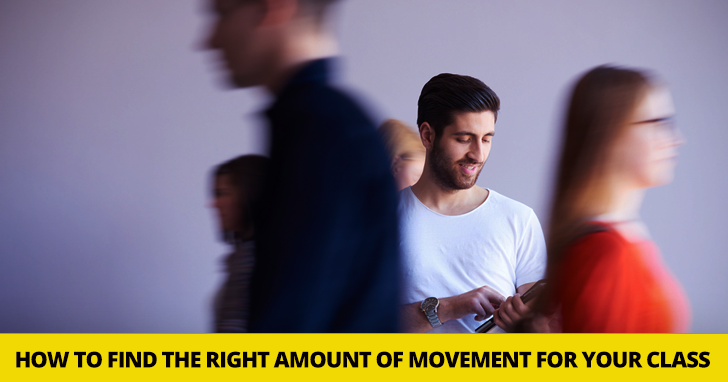Get Up And Get Moving: 5 Tips For Finding The Right Amount Of Movement For Your ESL Class


A long wait at the airport: “We just had to sit there for three hours while they tried to fix the plane”. A painfully dull lecture: “He just went on and on and on while everyone just sat there, staring into space”. A crowded doctor’s office: “I had to sit there for an hour before he would see me.”
Sitting still connects to some of the least interesting parts of our lives. A lack of movement seems to indicate a lack of attention and enthusiasm. It’s as though if we’re unmoving, we’re unengaged. This is surely true of a dull lecture or class; sitting still, our brains locked in ‘receive’ mode, we are unlikely to derive the optimal benefit from the class.

When learning to teach, many of us are encouraged to list the interaction pattern for each section of the class: Review (student-teacher); Presentation (teacher-student); Practice (student-student) and so on. I include a seating plan which I think will add the most to our work, and any ideas I have for getting the students out of their seats.
Where the material allows for it, I like to split up the class into manageable sections. Each of these could have a different location or aspect of movement. For instance, during review we could be in small teams for a quiz, but then during presentation, we’re back at our desks. Then, during practice, we’re up and about, working with a random partner in a pair. For feedback, some students come to the board. There will be classes where this won’t work (reading and listening perhaps) but keep in mind how long the students have been in one place, and try to introduce variety.
In China, we were set the challenge of hosting an ‘English Corner’. After some discussion and experiment, we found that a good way to keep the students both engaged and in motion was to post conversation topics on the wall in each corner of the room. Using the wall clock, we then moved on each group after five or ten minutes, so that they dealt with a different question – and therefore a different lexicon and new grammar – each time they moved.
“What does your partner think? Find out and tell me in five minutes.” This routine activity from my classroom receives a new lease of life if the students are required to speak to someone who is not sitting near them. I encourage this with, “Talk to someone you don’t know well,” or, “Find someone who you’ll need to introduce yourself too. Don’t worry, they won’t bite!” Some of the noisiest (i.e. most successful) speaking classes I’ve experienced have been sets of one-to-one interviews carried out by standing together somewhere in the classroom.
These rambunctious discussions can require a little management. Consider putting a time limit on the exercise, but prepare to extend it if the students are going well. I define this by asking questions:
How do you chastise your students? I’m happy to say that I’ve never raised my voice in a classroom. Instead, I use good-natured, light-hearted humiliation, and this is where movement can come in. Turn on the radio, or choose a song from Youtube, and require the student to dance for their classmates until you tell them to stop (or until everyone’s laughed quite enough!)
When training music students in aural skills, we started every 8am class with some gentle, slow stretching in an assigned pattern (reach up, then left and right, then touch your toes) followed by taking deep breaths using a slow four-count for inhalation and exhalation. Moving around right at the beginning of a morning class did wonders for my sleepy students. Deep breathing is also connected to the meditative experience, and may bring additional focus and concentration.
Many cultures use very few hand gestures compared to those of the English-speaking world. I teach these gestures to my students, both for fun, and for the cultural knowledge they provide. Some gestures are very useful aids to communication, helping to bridge the language gap and express those ideas the student is not yet able to talk about.
I hope your students are able to get out of their seats and enjoy the change of scenery.